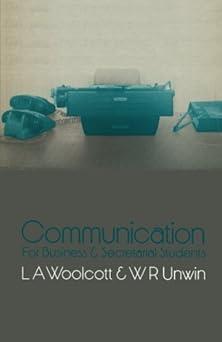Read the following passage and then answer the questions which follow. Through the centuries Art has reflected
Question:
Read the following passage and then answer the questions which follow.
Through the centuries Art has reflected wide variations of tastes that have responded to national, religious, geographical and even political incentives.
But hitherto, however disparate these extremes of taste may have been, the expression of them has presumed a perfection of execution within the limits of contemporary competence. Never before in the history of Art have technical skills become suspect as means of interpretating beauty - of producing works instinct with that beauty and nobility that Dr Barnes Wallis quoted Baudelaire as asserting were the products of 'reason and calculation'.
On this account practising artists, who have been lucky enough to survive the physical hazards of the present century, have experienced an unprecedented aesthetic and psychological convulsion and in the face of it are enduring intellectual stresses to which no other generation of their profession has been subjected since man's emergence as a user and designer of tools.
For thousands of years there was no discrimination between art and industry. Both were inspired to meet the practical and pleasurable needs of mankind. However futile those needs might have been, they were met by craftsm~n and engineers with a seriousness of purpose that was manifest in the perfection of their execution; the humblest pottery, the most frivolous jewellery and the most ornate furniture - all were made in the act of creation, in the conscious exercise of reason and calculation. Even in the sophistication of the Arts that marked the Renaissance the creator had no title but the recognition of his skill. Had that supreme architect, sculptor and painter, Michelangelo, been asked by a tax collector to state his profession he would have found no word in his language to describe it. Leonardo da Vinci (who as a consultant engineer today would be much sought after by Vickers, Pearson, Dorman Long and the Atomic Energy Commission) would have been content to call himself a painter, convinced that of all his preoccupations this was the most exacting, the most subtle and the most precise.
Lord Snow has realised, perhaps tardily, that the distinction between science and technology is now untenable. 'If you actually see', he writes, 'someone design an aircraft you find him going through the same experience - aesthetic, intellectual, moral - as though he was setting up an experiment in particle physics.' Until the present century this experience was shared by all creative workers - it is implicit in the exercise of reason and calculation.
But in the middle of the nineteenth century something went wrong. A schism rent the Arts and created a growing distinction and even antagonism between the fine and the applied. Simultaneously the fine arts suffered a crisis in patronage and performance. Professor Wind aptly allegorised the consequences of this crisis when he described the artist becoming isolated in his temple or sanctuary, its forecourt empty of all but a few dealers, and, he might have added, critics, who established themselves as the only means of communication between him and his erstwhile patrons, now, diffident and unsure of themselves, hanging about outside the precincts of his temple. His isolation, unhappily, coincided with the failure of two successive generations of painters to transmit the traditional techniques of their craft to the next.
Thus, when the means employed by artists became more desirable and negotiable than the ends they once served; when, as Paul Valery wrote, 'the taste for sketches and studies had raised the value of the unfinished to a point where it would appear in museums and had corrupted the stem old rule of the craft of painting', the artist became more easily reconciled to the poverty of his technical accomplishment and attuned to respond to the preachments of such prophets as Roger Fry whose fumbling painting and crude experiment in applied art in his Omega workshops helped to set the fashion for studied incompetence. And as time went on patron and public alike became blind in their aesthetic ecstasy to the probability that within measurable time contemporary works of art that were changing hands for large sums might, owing to inherent technical defects, disintegrate and tinkle to the floors of the public and private galleries where they were hung.
From an address 'The Mfectation of Imperfection'
to the Royal Society of Arts, Lawrence Irving, O.B.E.J R.D.L
(a) Give the passage a title and write a summary of the first two paragraphs in about 120 of your own words.
(b) (i) The author uses the phrase 'reason and calculation' more than once in the passage. What are the distinctions in meaning between 'reason' and 'calculation' as the author uses them in their context?
(ii) From the third paragraph, what would you infer might have been the distinction Lord Snow made between science and technology?
(iii) Early in the last paragraph, the critics are mentioned. Give briefly (four or five lines), in your view, what the role of the critic of the arts should be.
L.C.C. Private Secretary's Certificate
Step by Step Answer:

Communication For Business And Secretarial Students
ISBN: 9780333261750
1st Edition
Authors: Lysbeth A Woolcott, Wendy R Unwin






